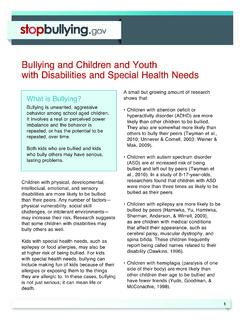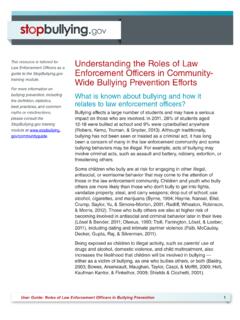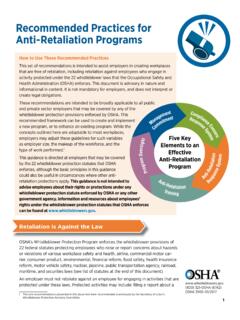Transcription of Understanding the Roles of School Administrators in ...
1 1 User Guide: Roles of School Administrators in bullying PreventionUnderstanding the Roles of School Administrators in community - wide bullying prevention EffortsBullying is unwanted, aggressive behavior among School -aged children that involves a real or perceived power imbalance. The behavior is repeated, or has the potential to be repeated, over time. bullying includes actions such as making threats, spreading rumors, attacking someone physically or verbally and excluding someone from a group on purpose. School Administrators Unique Role in addressing BullyingHow can School Administrators help to prevent bullying ? School Administrators , including principals, district-level Administrators , superintendents and School board members, can use these research-based best practices in bullying prevention and response: Focus on the School climate.
2 To reduce bullying and create a positive environment where youth feel safe and connected, it is important to focus on the social climate of the School . Assess bullying . Since adults are not always accurate in estimating the nature and prevalence of bullying (Bradshaw, Sawyer, & O Brennan, 2007), it is important for School Administrators to collect local data on bullying , School climate, and youth violence. Doing so can help raise awareness and motivate adults to take action, among many other critical benefits. Raise and seek out support for bullying prevention . Effective bullying prevention and intervention responses require early and enthusiastic support from School leaders and commitment from a majority of faculty, staff, students, adult mentors, and community partners. This resource is tailored for School Administrators as a guide to the training module.
3 For more information on bullying prevention , including the definition, statistics, best practices, and common myths or misdirections, please consult the training module at Guide: Roles of School Administrators in bullying prevention Coordinate and integrate prevention efforts . Recognizing that schools are working to address not only bullying , but also other social and emotional problems, School Administrators can work to coordinate and integrate bullying prevention with other efforts . Provide training in bullying prevention and appropriate responses. High-quality training helps staff understand the nature of bullying and its effects; how to work with others to prevent bullying ; what policies and rules are in place; and how to stop bullying if it is observed, reported, or suspected. School staff training, such as the U.
4 S. Department of Education s, Creating a Safe and Respectful Environment in Our Nation s Classrooms, can help School Administrators get started. Respond consistently and appropriately when bullying happens. All staff should be prepared to respond appropriately on-the-spot whenever they observe bullying . Follow-up responses are often needed with involved students and parents, and referrals to mental health professionals may be helpful. Spend time talking with students and staff about bullying . These discussions help teachers keep their fingers on the pulse of students concerns and allow students time to express their views about bullying and other social and emotional issues. They also provide students with skills to address bullying and related issues. Establish and enforce clear rules and policies that address bullying .
5 Under state laws, most schools are required to develop policies about bullying . These rules and policies should provide students, families, and staff with clear guidance about appropriate student behavior. Harsh, inflexible discipline strategies, such as zero tolerance policies, should be avoided. Such policies have been found to harm student-adult relationships, dampen School climate, and contribute to poor student achievement (APA Zero Tolerance Task Force, 2008). Instead, graduated sanctions should be used for rule violations, which are appropriate for the developmental level of the child and the nature and severity of the bullying . Removal from the School -setting should be a measure of last resort. Increase adult supervision. bullying tends to thrive in locations where adults are not present or are not vigilant. Once hot spots have been identified, all adults should be on the lookout for bullying and other inappropriate behavior.
6 Continue efforts over time. bullying prevention is an ongoing, holistic effort that engages all members of a community over time and without an end date. Challenges & Opportunities for School AdministratorsSchool Administrators face a number of challenges in addressing bullying in schools: School staff and students often have different views of the extent of bullying and the efforts to address it. Nearly equal percentages of staff and students report being concerned about bullying at their School , but staff members significantly underestimate the numbers of students who are frequently involved in bullying . In addition, whereas most students believe their School is not doing enough to prevent bullying , most staff feel their prevention efforts are adequate (Bradshaw et al., 2007). Many children and youth do not report bullying to an adult at School .
7 Children are less likely to report bullying to School staff than to parents or friends (Limber, Olweus & Wang, 2012; Waasdorp & Bradshaw, 2011). Their reluctance to report bullying to staff likely stem from negative messages about tattling and snitching, concern about retaliation, and lack of confidence in adults responses to bullying (Kowalski, Limber & Agatston, 2012). Many staff have not received sufficient training. Although the vast majority of School employees (93%) indicate that their district has implemented a bullying prevention policy, only about half (54%) had received training related to that policy (Bradshaw, Waasdorp, O Brennan, & Gulemetova, 2011). Many are not directly involved in bullying prevention efforts . In a national survey of more than 5,000 School staff, 60% reported that their School had formal bullying prevention efforts ( a School team, a committee, or a prevention program), but fewer than 40% reported being directly involved in these activities (Bradshaw et al.)
8 , 2011). Staff experience multiple demands on their time. School staff have many Roles and experience multiple demands on their time. Even if staff members realize the importance of bullying prevention , principals, district-level Administrators , and School board members can support these efforts and make them a priority. Despite these challenges, there are important opportunities for School Administrators to make a difference. Many educators are concerned about bullying . The vast majority of educators view it as their job to intervene when they witness bullying incidents (Bradshaw et al., 2007; Bradshaw et al., 2011). They recognize the effects that bullying can have on the academic, social, emotional, and physical well-being of their students. Education support professionals are untapped resources for bullying prevention efforts in many schools.
9 Most have witnessed bullying and are eager and committed to addressing bullying in schools, yet they tend to be less involved than teachers in training and prevention activities. 3 User Guide: Roles of School Administrators in bullying prevention Opportunities for partnership and collaboration. With the passage of anti- bullying laws in nearly every state, most School districts are required to develop policies to address bullying at School . School Administrators can bring their unique expertise, a collaborative approach, and leadership to the development and refinement of these policies, and to the implementation of evidence-based prevention and intervention approaches that meet the needs of their teachers, staff, students and families. In doing so, they can help to ensure that common misdirections in bullying prevention and response are avoided, such as the implementation of zero tolerance policies, which can isolate and harm individual students and contribute to a climate of alienation and distrust at School (APA Zero Tolerance Task Force, 2008).
10 How School Administrators Can Engage and Include Others in community bullying prevention StrategiesBecause of their experiences in addressing bullying and related problems at School ; their concern for and Understanding of the harm that it causes; and their expertise in addressing academic and social needs of children, School Administrators can assist in leading community - wide bullying prevention efforts in and outside-of schools. Using the community Action Toolkit, educators can work with School personnel, students, families, and other community stakeholders to get started. Ideas for Next Steps Learn more about bullying prevention through and the resources listed below. Review the research presented in the modules and how it is best communicated among your colleagues, with staff, and other motivated audiences. Review existing data within your School or community regarding bullying .










